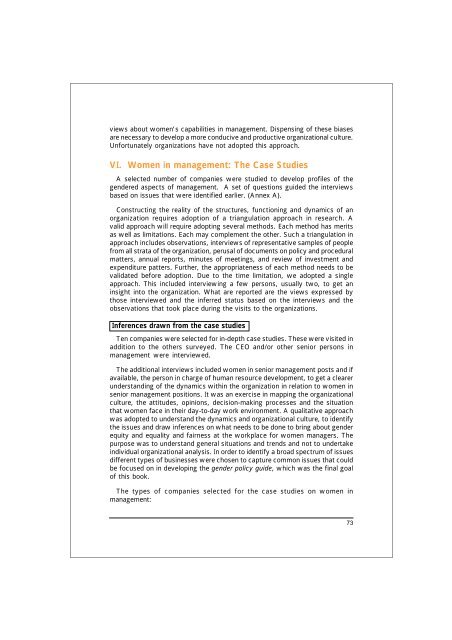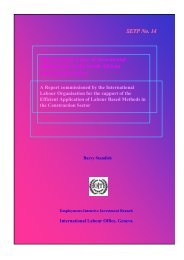Beyond Glass Ceilings and Brick Walls - International Labour ...
Beyond Glass Ceilings and Brick Walls - International Labour ...
Beyond Glass Ceilings and Brick Walls - International Labour ...
You also want an ePaper? Increase the reach of your titles
YUMPU automatically turns print PDFs into web optimized ePapers that Google loves.
views about women’s capabilities in management. Dispensing of these biases<br />
are necessary to develop a more conducive <strong>and</strong> productive organizational culture.<br />
Unfortunately organizations have not adopted this approach.<br />
VI. Women in management: The Case Studies<br />
A selected number of companies were studied to develop profiles of the<br />
gendered aspects of management. A set of questions guided the interviews<br />
based on issues that were identified earlier. (Annex A).<br />
Constructing the reality of the structures, functioning <strong>and</strong> dynamics of an<br />
organization requires adoption of a triangulation approach in research. A<br />
valid approach will require adopting several methods. Each method has merits<br />
as well as limitations. Each may complement the other. Such a triangulation in<br />
approach includes observations, interviews of representative samples of people<br />
from all strata of the organization, perusal of documents on policy <strong>and</strong> procedural<br />
matters, annual reports, minutes of meetings, <strong>and</strong> review of investment <strong>and</strong><br />
expenditure patters. Further, the appropriateness of each method needs to be<br />
validated before adoption. Due to the time limitation, we adopted a single<br />
approach. This included interviewing a few persons, usually two, to get an<br />
insight into the organization. What are reported are the views expressed by<br />
those interviewed <strong>and</strong> the inferred status based on the interviews <strong>and</strong> the<br />
observations that took place during the visits to the organizations.<br />
Inferences drawn from the case studies<br />
Ten companies were selected for in-depth case studies. These were visited in<br />
addition to the others surveyed. The CEO <strong>and</strong>/or other senior persons in<br />
management were interviewed.<br />
The additional interviews included women in senior management posts <strong>and</strong> if<br />
available, the person in charge of human resource development, to get a clearer<br />
underst<strong>and</strong>ing of the dynamics within the organization in relation to women in<br />
senior management positions. It was an exercise in mapping the organizational<br />
culture, the attitudes, opinions, decision-making processes <strong>and</strong> the situation<br />
that women face in their day-to-day work environment. A qualitative approach<br />
was adopted to underst<strong>and</strong> the dynamics <strong>and</strong> organizational culture, to identify<br />
the issues <strong>and</strong> draw inferences on what needs to be done to bring about gender<br />
equity <strong>and</strong> equality <strong>and</strong> fairness at the workplace for women managers. The<br />
purpose was to underst<strong>and</strong> general situations <strong>and</strong> trends <strong>and</strong> not to undertake<br />
individual organizational analysis. In order to identify a broad spectrum of issues<br />
different types of businesses were chosen to capture common issues that could<br />
be focused on in developing the gender policy guide, which was the final goal<br />
of this book.<br />
The types of companies selected for the case studies on women in<br />
management:<br />
73
















